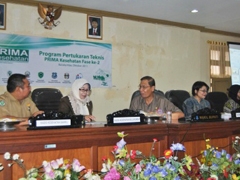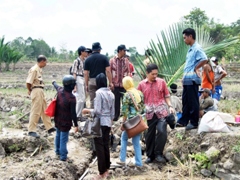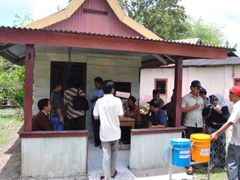- Home
- Technical Cooperation Projects
- Index of Countries
- Asia
- Indonesia
- Project for Improvement of District Health Management Capacity in South Sulawesi Province Phase 2
- Project News
- Technical Exchange Program of PRIMA Kesehatan Phase-2
Project News
2011-12-01
Technical Exchange Program of PRIMA Kesehatan Phase-2

Technical Exchange Program of PRIMA Kesehatan Phase-2 for 3 target districts i.e. Barru District, Bulukumba District and Wajo District has been implemented during the period of October-December 2011. The objective of Technical Exchange Program was (1) to enhance community knowledge about Primary Health Care Improvement (PHCI) activities through sharing experiences and ideas, (2) to obtain new ideas about action plan for PHCI activities in cycle 2, (3) to develop good relationship and communication among government and Health Working Group (HWG) in the level of villages/wards, sub districts and districts. The participants of Technical Exchange Program were head of village, head of HWG, health center facilitator, head of sub-district, sub-district facilitator, the district team member, district coordinator and field facilitator.

First visit was done by Barru team to Bulukumba district. The team was divided into 2 groups. First group (Group I) of 64 members departed on 10 – 11 October 2011. The group visited a family toilet construction site in Anrang village and a clean water piping system installation site with ± 800m pipe length in Pandang-pandang, Baji Minasa village. Second group (Group II) of 71 people from Barru visited Bulukumba on 14-15 October. This group visited a dental hygiene activity at the 32nd Barabba elementary school, Bialo village, were around 200 students of Kindergarten and Elementary School participated in that elucidation. Next, the group visited SPAL (waste water disposal system) located in Bialo Village, which was constructed and funded by the community itself after experiencing SPAL Pilot of PRIMA Kesehatan Phase-1.

It was Bulukumba district’s turn to visit Barru on 24 -25 October 2011 (Group I) and 25-26 October (Group II). Group I consisted of 83 people. Arrived in Barru, they headed for a well construction site at Lampoko village, Balusu. After that, the group went to the office of Pao-pao village for hearing presentation about their activities. Group II of 78 Bulukumba district members arrived on 25 October. On 26 October, Group II visited Tompo village. In Tompo, the participants a dental hygiene activity as a part of a clean and healthy life behaviour (PHBS) at Inpres Tompo elementary school. Using Upin and Ipin puppets attracted the students. Group II visited a Posyandu, an integrated health service post, constructed by a community during PRIMA Kesehatan Phase-1 and a sample of garbage bin installed by a health working group near Posyandu. The last destination for Group II of Bulukumba was Galung village. At Galung the participants listened to a presentation about Financial Management of Galung village government presented by Mr. Ahmad Suhada, Head of Galung village and by a health working group of Galung.
From 30 November to 1 December, Wajo District has an opportunity to visit Bulukumba District. Like previous groups, Wajo team was also divided into 2 groups 88 and 98 people respectively. The sites being selected to be visited were family toilette construction at Bulo-bulo and construction of a permanent Posyandu at Sapobonto village, Bulukumpa. Those places were selected because the amount of village budget given to the health working groups was quite big compared to other villages. Unlike previous visits, Wajo team’s program was interesting and different, because they stayed at a villager’s house. This would make the participants directly interact with villagers about the experiences in primary health activities at village level.
Through the mutual visiting, the participants acquired valuable information and shared the experiences in management of primary health care activities. Technical Exchange Program certainly became a place to develop better relations between the village governments and health working groups both within a district and among these 3 districts. .
- About JICA
- News & Features
- Countries & Regions
- Our Work
- Thematic Issues
- Types of Assistance
- Partnerships with Other Development Partners
- Climate Change / Environmental and Social Considerations
- Evaluations
- Compliance and Anti-corruption
- Science and Technology Cooperation on Global Issues
- Research
- JICA Development Studies Program / JICA Chair
- Support for the Acceptance of Foreign HRs / Multicultural and Inclusive Community
- Publications
- Investor Relations
